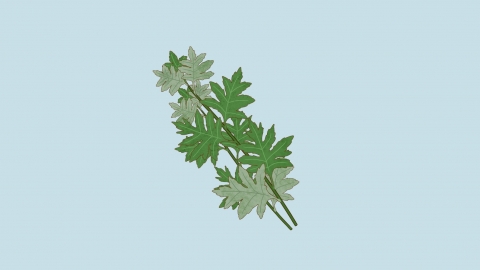Can mugwort and Pulsatilla chinensis be taken together?
Generally, Artemisia argyi (Ai Cao) and Pulsatilla chinensis (Bai Tou Weng) can be used together in the treatment of disorders caused by damp-heat descending or cold-dampness syndromes. However, when the condition contradicts the properties of these herbs or the patient's constitution is unsuitable, they should not be used together. If there are any concerns, it is recommended to consult a physician in advance. A detailed explanation is as follows:

Artemisia argyi is warm in nature and has the effects of dispersing cold to relieve pain and warming the meridians to stop bleeding. It is commonly used to treat bleeding and abdominal pain caused by deficiency cold syndromes. In contrast, Pulsatilla chinensis is cold in nature and has functions of clearing heat, detoxifying, cooling the blood, and stopping dysentery. It is suitable for treating conditions such as heat-toxin dysentery and damp-heat descending syndrome. When used together, Artemisia argyi can moderate the cold nature of Pulsatilla chinensis, reducing its irritation to the stomach and spleen. Simultaneously, the two herbs synergistically exert effects of clearing heat and removing dampness, as well as dispersing cold and relieving pain, making them effective for treating damp-heat descending syndrome or diseases related to cold-dampness, such as leukorrhea and diarrhea.
However, in cases of intense heat toxicity or yin deficiency with fire hyperactivity (excess heat syndromes), the cold nature of Pulsatilla chinensis may be more appropriate, whereas the warm nature of Artemisia argyi might exacerbate the condition. Additionally, if the patient has a cold constitution or symptoms of spleen-stomach deficiency cold, using Pulsatilla chinensis alone may be sufficient. Adding Artemisia argyi may further impair the yang energy of the spleen and stomach, leading to adverse reactions.
Before using Artemisia argyi and Pulsatilla chinensis, it is important to consult a qualified TCM practitioner to determine whether your constitution and condition are suitable for these herbs. During use, monitor your body's response closely and seek medical attention promptly if any adverse effects occur.
References
[1] Yang Dan, Si Fuchun. Research Progress on Pharmacological Effects, Clinical Applications, and Quality Marker Prediction of the Classic Formula Bai Tou Weng Tang [J/OL]. Journal of Liaoning University of Traditional Chinese Medicine, 1-9 [2025-03-22].
[2] Zhang Wanping, Zhang Zhiruo, Zhang Dongmei, et al. Efficacy and Properties of Artemisia argyi Extract [J]. Food and Machinery, 2023, 39(04): 37-43.




